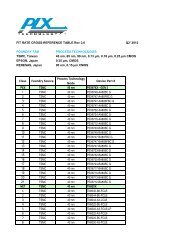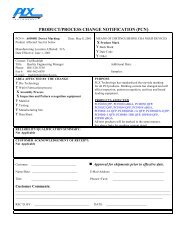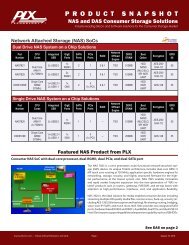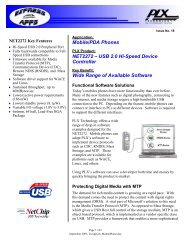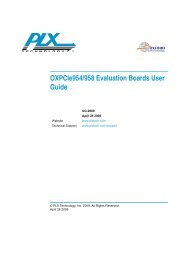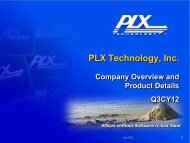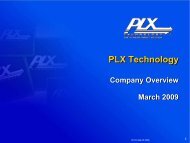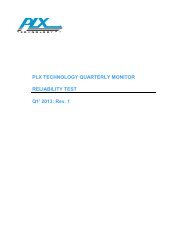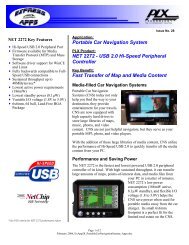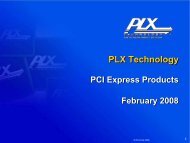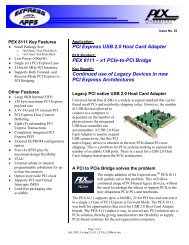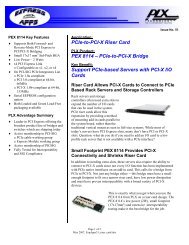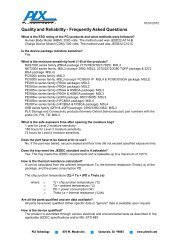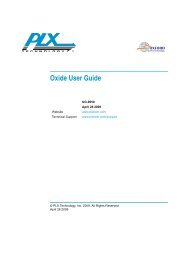the 2009 Annual Report (pdf) - PLX Technology
the 2009 Annual Report (pdf) - PLX Technology
the 2009 Annual Report (pdf) - PLX Technology
You also want an ePaper? Increase the reach of your titles
YUMPU automatically turns print PDFs into web optimized ePapers that Google loves.
December 31, 2008<br />
Amortized Unrealized Unrealized Estimated<br />
Cost Gain Loss Fair Value<br />
Corporate bonds and notes………………………………………… $ 9,898 $ 92 $ (47) $ 9,943<br />
Municipal bonds……………………………………………………… 1,509 6 - 1,515<br />
US treasury and government agencies securities………………… 28,564 240 - 28,804<br />
Total short and long-term available-for-sale investments…… $ 39,971 $ 338 $ (47) $ 40,262<br />
Contractual maturity dates for investments:<br />
Less than one year………………………………………………… 32,677<br />
One to two years…………………………………………………… 7,585<br />
$ 40,262<br />
The Company reviews its available for sale investments for impairment at <strong>the</strong> end of each period. Investments in<br />
debt securities, which make up <strong>the</strong> majority of <strong>the</strong> Company’s investments, are considered impaired when <strong>the</strong> fair<br />
value of <strong>the</strong> debt security is below its amortized cost. If an impairment exists and <strong>the</strong> Company determines it has<br />
intent to sell <strong>the</strong> debt security or if it is more likely than not that it will be required to sell <strong>the</strong> debt security before<br />
recovery of its amortized cost basis, an o<strong>the</strong>r-than-temporary impairment loss is recognized in earnings to write <strong>the</strong><br />
debt security down to its fair value. However, even if <strong>the</strong> Company does not expect to sell <strong>the</strong> debt security, it must<br />
evaluate expected cash flows to be received and determine if a credit loss exists. In <strong>the</strong> event of a credit loss, only <strong>the</strong><br />
amount of impairment associated with <strong>the</strong> credit loss is recognized in earnings. Amounts relating to factors o<strong>the</strong>r than<br />
credit losses are recognized in o<strong>the</strong>r comprehensive income (loss). The Company did not record any o<strong>the</strong>r-thantemporary<br />
write-downs in <strong>the</strong> accompanying financial statements.<br />
5. Concentrations of Credit, Customer and Supplier Risk<br />
Financial instruments that potentially subject <strong>the</strong> Company to concentrations of credit risk consist primarily of<br />
cash equivalents, short-term investments, long-term investments and trade receivables. The Company generally<br />
invests its excess cash in money market funds, commercial paper of corporations with high credit ratings, municipal<br />
bonds and treasury bills. The Company’s cash, cash equivalents, short and long-term investments were approximately<br />
$40.0 million as of December 31, <strong>2009</strong> which exceeded <strong>the</strong> amount insured by <strong>the</strong> Federal Deposit Insurance<br />
Corporation (“FDIC”). The Company has not experienced any significant losses on its cash equivalents or short and<br />
long-term investments.<br />
The Company performs ongoing credit evaluations of its customers and generally requires no collateral.<br />
Customers who accounted for 10% or more of net accounts receivable are as follows:<br />
Years Ended December 31,<br />
<strong>2009</strong> 2008 2007<br />
Excelpoint Systems Pte Ltd…………………………… 25% 36% 31%<br />
Promate Electronics Co., Ltd………………………… 14% - *%<br />
Answer <strong>Technology</strong>, Inc.……………………………… 18% 18% 14%<br />
Avnet, Inc.…………………………………………… 21% 10% 13%<br />
∗ Less than 10%<br />
54




